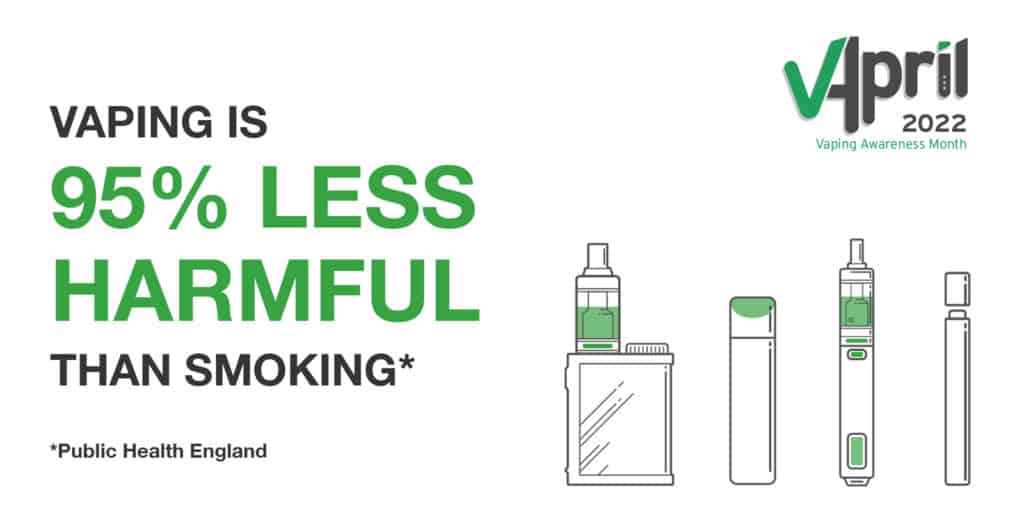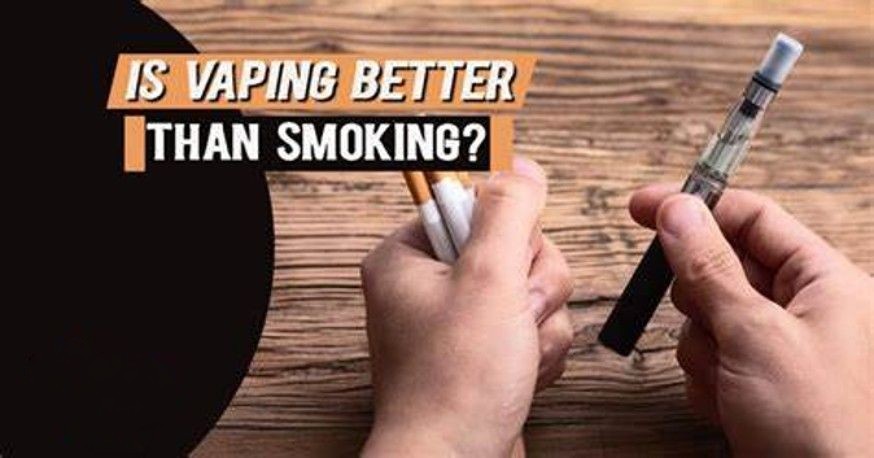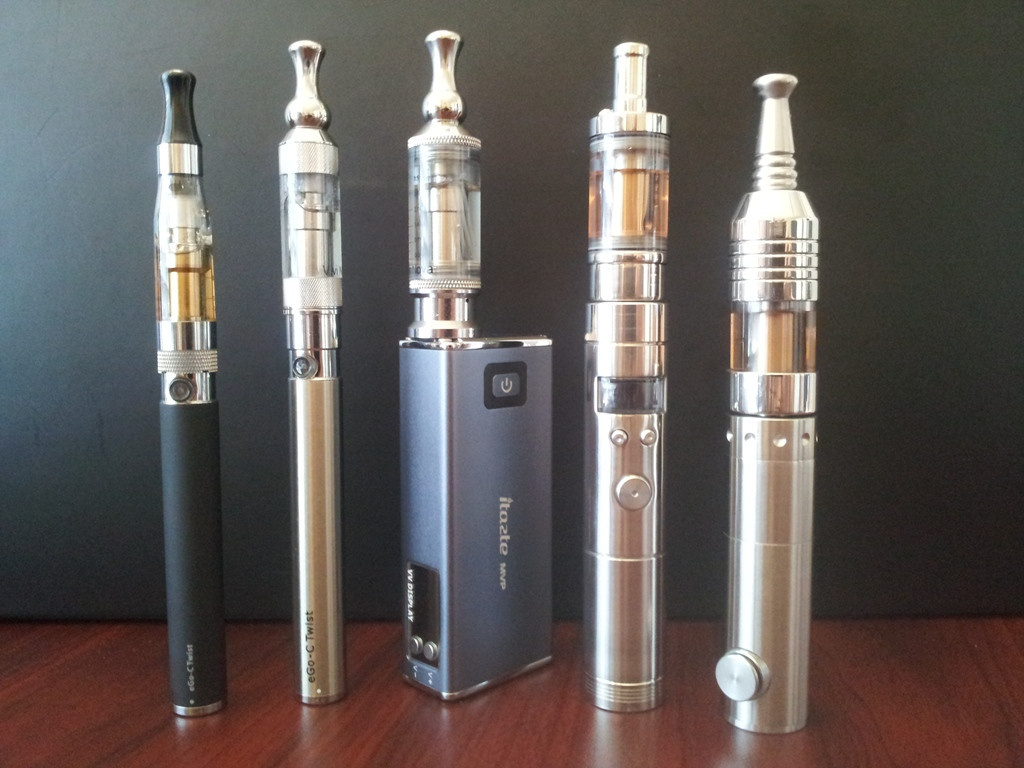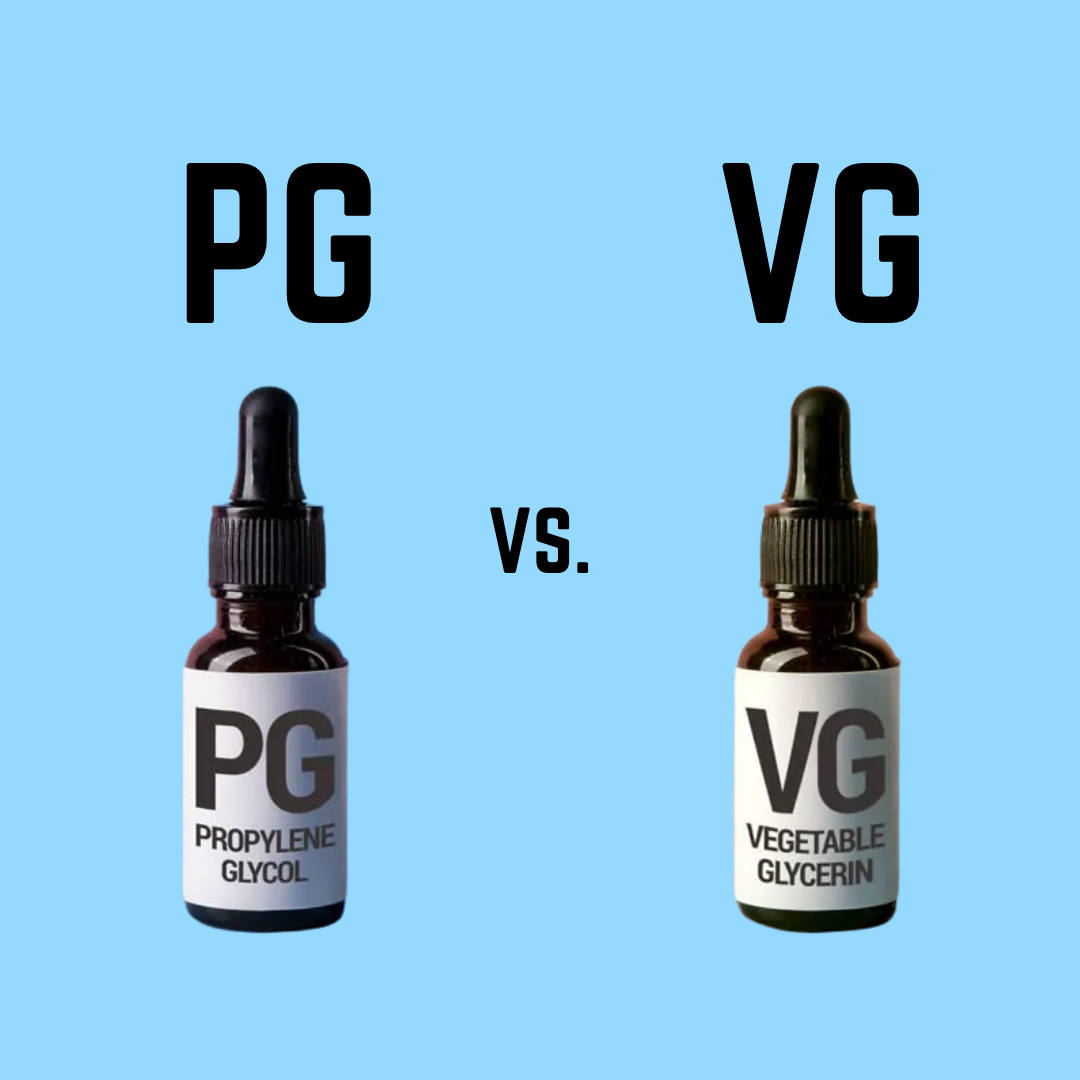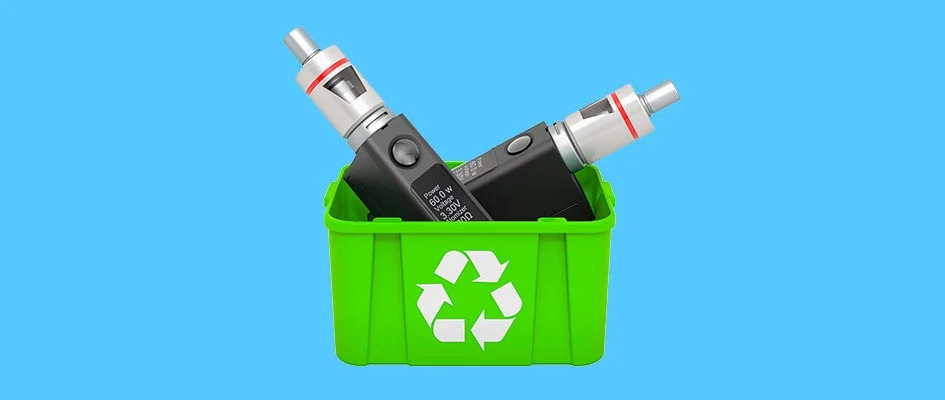VAPING VS. SMOKING: THE SAFETY DEBATE

The whole reason that e-cigarettes were invented was to provide a less harmful alternative to smoking - one which - unlike traditional NRT’s (Patches, gum etc) - actually feels like smoking, and gives you a genuinely satisfying nicotine hit. Something that is still actually pleasurable, but without the known problems associated with smoking. So naturally, ever since their conception, there has been a great deal of debate over just how safe vape kits really are.
With well over a decade since the first generation of the humble e-cig hit the market, we’ve seen a lot of good and a lot of bad research into vaping/vapour, as well as the dedicated devices and vape liquids used to create it. In the following sections, we’d like to try and sift the fact from fiction and provide you with a brief overview of the evidence for Vaping vs Smoking.
1. THE BASIC PREMISE
Since the 1950’s it has been increasingly well documented that it is the combustion of tobacco and the resultant smoke and tar inhaled, that cause the diseases associated with smoking. These include, lung cancer, COPD, cardiovascular disease, bronchitis, emphysema, and so on. One of the founding fathers of tobacco cessation, Professor Michael Russell, wrote:
People smoke for nicotine, but they die from the tar".
There are over 5000 chemicals contained in cigarette smoke (source), over 70 of which are known carcinogens. Some occur naturally in the tobacco itself, some come from fertilisers used during cultivation, others get added during the processing stages (including preservatives, flavour enhancers etc), and others are actually created during the combustion process itself.
So the basic premise and the fundamental reason why vaping is less harmful than smoking is quite simple – there is no combustion of tobacco, therefore no smoke, no tar and none of the associated problems. Rather than 5000+ chemicals, the nicotine containing solution or e-liquid, has a relatively simple list of ingredients:
Propylene glycol (PG) and/or vegetable glycerin (VG), nicotine (usually) and flavouring. Sometimes the manufacturer may add a little distilled water to thin out the mixture, but that is basically it.
2. ARE THE INGREDIENTS REALLY LOW RISK?
PG and VG (guide to eliquids) are used as the base liquid which carries both the nicotine and the flavouring. Along with the nicotine itself they help to provide the familiar ‘throat hit’ which smokers expect. These 2 ingredients are also what cause the visible vapour that you see, something you don’t get with water vapour and again this helps to mimic the smoking experience.
Both PG and VG are widely used in everyday cosmetics and pharmaceutical products. PG is also used in many foodstuffs, as well as asthma inhalers and nebulisers. Both are considered fairly inert although some people do have a sensitivity to them, and a rare few are unfortunately allergic.
VG is thicker than PG with a slightly sweet taste, but it doesn’t give as much throat hit or carry flavour quite as well. Due to these different properties, varying ratios of both base components are often used in e-liquids (50/50, 60/40, 70/30 etc).
3. BUT… NICOTINE?
Nowadays people are becoming more and more aware that nicotine itself is actually a relatively harmless stimulant (source), very similar in nature to caffeine at the dosage generally used in e-cigarettes and vaping. And contrary to many anti-smoking campaigners, nicotine has no link to cancer.
Yes pure nicotine is a deadly poison, but there is a very old phrase in toxicology “the dose makes the poison” – the often added cliché (source) is that even water is toxic if you drink enough .
“Nicotine itself is not a particularly hazardous drug, It’s something on a par with the effects you get from caffeine” and that “If all the smokers in Britain stopped smoking cigarettes and started smoking e-cigarettes we would save 5 million deaths in people who are alive today. It’s a massive public health prize”
4. AND THE REST OF IT!
Well indeed, if e-liquid consisted only of PG, VG and nicotine there would be a shorter story to tell, but there is of course the factor of flavourings. Every reputable manufacturer will only use the highest grade food flavours, and obviously scientists are satisfied these are safe for human consumption when ingested, but when vapourised and inhaled the data simply isn’t there in many cases.
This is part of the reason we often hear phrases in the media similar to: !!“We have no idea what the long term effects of vaping will be”!!!!
5. SO WHAT DOES SCIENCE TELL US?
There is a very broad area and covers a lot of different aspects, the best way to present this information is to look at this from a critic’s point of view and go through the list of concerns and allegations that are stated about vaping.
A. E-Cigarettes Contain More Formaldehyde Than A Cigarette
The main culprit for this myth was a report in the New England Journal of Medicine: Jensen et al Hidden Formaldehyde in E-cigarette Aerosols. In this report the authors suggest that exposure to formaldehyde through e-cigarettes was in the region of 5-15 times higher than a combustible tobacco cigarette. Naturally this sent shockwaves through the media and was a very well covered story… however the study was fundamentally flawed and the facts are actually rather different. Unfortunately this hasn’t been so well publicised.
The major flaw with this study was the fact that the e-cigarette was tested under very unrealistic conditions, which would never be replicated by a vaper. The device was operated at such a high temperature (far above the recommended use) that the e-liquid was unable to wick fast enough, causing what are known as ‘dry puffs’ - where the atomizer heats up but the cotton is dry and causes it to burn rather than vapourising the liquid. It is this process that produces thermal degradation products - including formaldehyde.
What this study really showed us was that if used in the wrong conditions that the devices were capable of producing large amounts of formaldehyde, but more interestingly - that the scientist’s conducting these experiments simply did not understand the devices they were testing and the proper use of them. Something you would imagine to be fundamental when conducting a scientific study.
B. Vaping Is As Bad For Your Heart As Cigarettes
A myth which has been perpetuated by most of the tabloids. The Sun actually ran this as a front page headline, while The Daily Mail, The Mirror, The Telegraph and The Times all ran major pieces too.
The claims were made at the European Society of Cardiology congress in italy, by Professor Charalambos Vlachopoulos, of the University of Athens Medical School, and despite the alarming headlines it turned out to be a bit of a storm in a teacup. It was claimed that vaping increases aortic stiffness and blood pressure, yet this is a known side effect of nicotine and very similar results occur from drinking coffee or taking exercise.
Queen Mary University London, explains it very well:
!!" The study is reporting on a well-known short-term effect of nicotine – stiffening of arteries – that accompanies all types of stimulation. The same effect is generated by watching a thriller or a football match or sitting an exam. Drinking a cup of coffee actually produces a larger response of much longer duration. The key heart health risks of smoking are not caused by nicotine but by other chemicals in tobacco smoke that are not present in e-cigarette vapour.”!!
C. Passive Vaping
Nowadays we are all aware of the dangers caused by passive smoking, so it was natural that people would have concerns around vaping. Fortunately several studies have been conducted which all point to the conclusion that passive exposure to vapour poses little to no danger at all.
!! “The above experiment, within the limits of the observed parameters, has underlined that e-smoking does not produce detectable amounts of toxic and carcinogenic substances in the air of an enclosed space. Further studies are needed to better understand all the involved aspects. However this preliminary assessment indicates that passive vaping impact, when compared to the traditional cigarette smoking, is so low that it is just detectable, and it does not have the toxic and carcinogenic characteristics of cigarette smoking. The absence of combustion and the lack of side stream smoking, with its known toxic effects] are probably the main reasons for the differences observed in air pollution characteristics”
D. Vaping Is A Gateway To Smoking For Children
This particular fallacy has unfortunately stemmed from the anti-smoking campaigners who are unable to make a distinction between vaping and smoking - under the impression that they are all tobacco products (which we all know they aren’t). And now even the US Surgeon General is spreading the misinformation and scaremongering too - https://e-cigarettes.surgeongeneral.gov
The major problem here is that the statistics actually point to the complete opposite conclusion. Just like for adults, e-cigarettes seem to be acting as a gateway AWAY from smoking
He rightly informs the reader that youth use of e-cigarettes has risen. The website tells us:
“Between 2011 and 2015, past-month e-cigarette use grew dramatically among middle school and high school students. E-cigarettes are now the most commonly used form of tobacco by youth in the United States. Dual use, or use of e-cigarettes and conventional cigarettes by the same person, is common among youth and young adults (ages 18-25).”

But what he doesn’t tell the reader is that coincides with a very significant drop in the rate of youth smoking in the US
E. Vaping Is As Bad For You Or Worse Than Cigarettes
There is a very alarming trend amongst adults in the UK, where perceptions that e-cigarettes are worse or as bad as smoking have actually increased by 18% over the last 3 years - despite the fact that more and more reports have been published which positively prove the opposite.
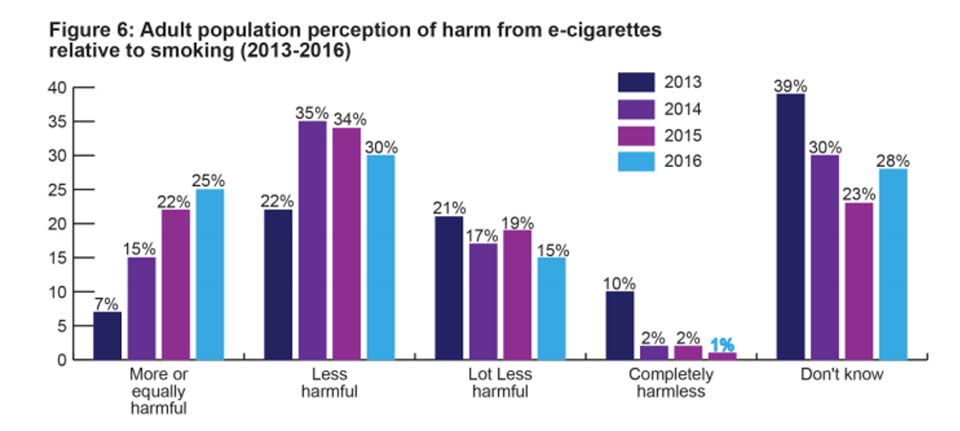
But how has this happened? It’s a perfect example of the power of the press. Simply put, the misinformation, poor reporting and the new clickbait culture have propagated false perception among the population. Let’s face it bad news sells papers, good news doesn’t - so even when the negative stories are debunked, they don’t get any column space and so the views of the general public are moulded on incorrect information - which in this particularly case is not just poor practice from the news outlets, but actually could prove fatal for many smokers.
So how much safe is vaping compared to smoking? Public Health England (PHE), are a government body whose purpose is to “to protect and improve the nation's health and wellbeing, and reduce health inequalities.” They state on the website that one of their responsibilities is:“researching, collecting and analysing data to improve our understanding of health and come up with answers to public health problems” and in the case of vaping that is exactly what they have done….
In August 2015 PHE published a ground-breaking, and internationally renowned report entitled E-Cigarettes: An Evidence Update. The report was commissioned by PHE and conducted by members of the National Centre for Tobacco and Alcohol Studies (lead by Ann McNeil and Peter Hajek). The report reviewed all of the evidence available at the time of writing. The aim being to:
The most important take home message here was that according to all the science available, vaping is 95% safer than smoking! It is not ‘safe’ (but inhaling anything other than clean air is not going to be 100% safe) but as an alternative to smoking it is an enormous public health win.
F. Product Safety and The Evolution of Vaping
Aside from the actual health impact, stories about poisoned pets and exploding batteries have naturally caused concern that the e-liquid containers and the vaping devices themselves are not safe. But what is the truth?
Contrary to popular belief, the devices and the refill liquids have been subject to the consumer goods regulations from day zero, however the enforcement of these regulations was a little lackadaisical and they weren’t really specific enough to cover all aspects of the products.
However in 2014 the Tobacco Products Directive (TPD) was updated to include new regulations for the manufacture and retail of nicotine containing liquid and vaping products. These regulations became law in 2016 and is known as the Tobacco and Related Products Regulations or TRPR.
Some of the regulations are considered by many businesses and consumers as far too over-reaching. The main ones being: a limit on e-liquid bottle size to 10ml (bleach is far more toxic and is available in litres!); tank size limited to 2ml (which means many people will have to fill their tank more often, and have more chance of spilling the liquid!); nicotine strength capped at 20mg/ml (significant percentage of vapers have started on 24mg.ml - particularly if they were a heavy smoker); and too many advertising restrictions.
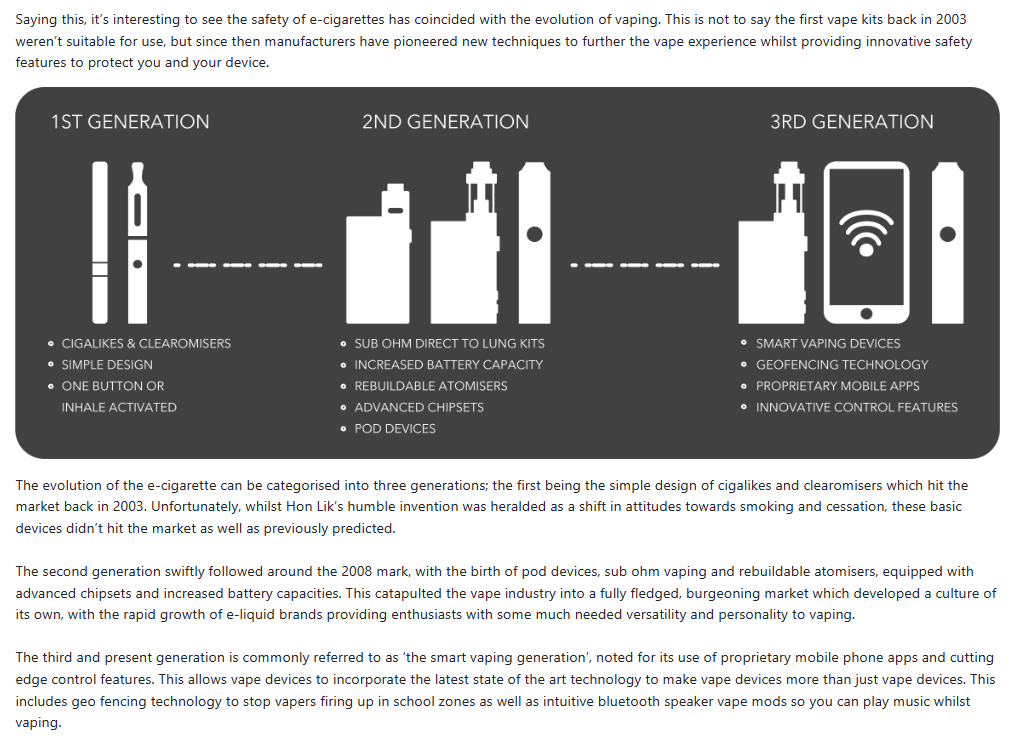
6. CONCERNS FOR THE FUTURE
As always there are concerns over the future of vaping, particularly in terms of tobacco companies wanting to reap their losses by trying to tarnish vaping at every possible occasion.
Vaping is not smoking, and does not involve the process of burning a substance like tobacco. Vaping is using an electronic device to create a vapor mixture from a liquid, which is known as an e-juice or e-liquid. This vapor is inhaled into the lungs and the residual vapor is expelled by the person vaping.
We’ve mentioned the need for vigilance and investigation a couple of times, but as of yet we do not have any data on the long term use of e-cigarettes and vaping. Without this, it is impossible to know the full story and it is something that can only reveal itself with time. However, there is resounding studies and evidence from admired public health organisations suggesting vaping is 95% less harmful than smoking, whilst also being a highly successful way to quit smoking entirely.
